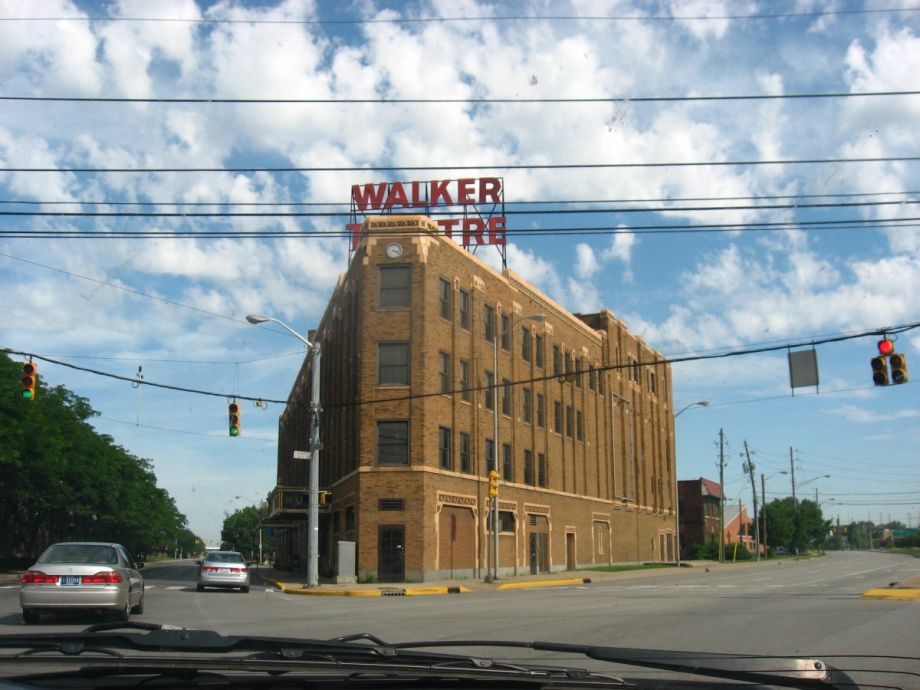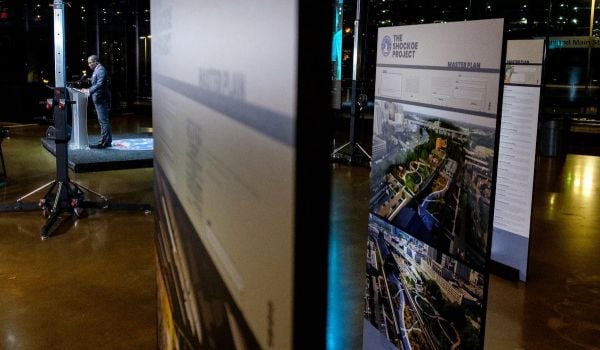In the never-ending quest for racial justice, the stretch of Indiana Avenue running northwest out of downtown Indianapolis has been a battlefront for more than a hundred years and counting.
When Black folks started fleeing the Jim Crow South at the start of the Great Migration, Indianapolis was one of the first places where they ended up. It was barely outside the South. When they got to Indianapolis, Black folks started some of the first urban farms, formed housing cooperatives and started grocery stores. They were so industrious and successful, when Madam C.J. Walker needed a place to scale up production of her famous hair products for Black women, she came to Indianapolis — right here to Indiana Avenue, where she moved her company headquarters in 1910.
For many decades, this stretch of Indiana Avenue was the one place in Indianapolis where Black folks could do business out loud. Jazz clubs and other Black-owned businesses ran all up and down the avenue, fueled in large part by the jobs from Walker’s company and others.
Today it’s mostly parking lots. One of the few remaining structures from that era is the building that housed the Madam Walker Theatre. It’s now owned by the Madam Walker Legacy Center, a nonprofit organization that runs programs in the building. Legend has it, Walker vowed to build a movie and performing arts theater after another one she’d frequented in town suddenly started charging Black folks an extra dime for admission. But she never got a chance to enjoy it — the theater didn’t open until eight years after she passed away.
A lot of Black folks in and around Indianapolis today don’t even realize what was taken away from them. Folks may know who Walker was, and what she did, but they may not know about the cultural significance of the neighborhood where she did it.
But now, the Black folks who have stuck it out here and those whose roots are here all have a new chance to shape the future of Indiana Avenue. Over the course of 2020, a multi-generational, multi-racial coalition came together in resistance to a project they viewed as an affront to Indiana Avenue’s former glory days as a Black business and cultural mecca. That project would have happened on land owned by the Madam Walker Legacy Center. After the public resistance, the project was scuttled, though it leaves a historic organization hanging in the balance.
Now, the people behind those efforts are inviting all interested voices to a new conversation to develop a community-based and city-endorsed neighborhood plan for the area. That plan will be rooted in the history of the neighborhood, even though the physical buildings that made up the neighborhood have been mostly torn down.
“The general goal is to build a new community centered in Blackness,” says Paula Brooks, an environmental justice activist and third-generation resident of the neighborhood. “I witnessed some challenges of living in a complete and vibrant community to becoming a community that was decimated and sterilized. What’s left has been under attack.”
As it has always done, white supremacy finds a way to undermine Black communities. Sometimes it’s loud, like the white riots that burned down Black Wall Street in Tulsa, Oklahoma, 100 years ago. But even when it’s quiet, it’s every bit as violent, which is what happened to Indiana Avenue. Building by building, block by block, denied access to capital for maintenance, festered, bulldozed, paved over. If you’ve seen it once, you’ve seen it a thousand times in inner-city Black communities across the country.
Almost as predictably, Black women started laying the groundwork before anyone else to reclaim a once-beloved, thriving neighborhood.
In the late 1980s, Jean Spears moved back to her home neighborhood. Known as Ransom Place, the area is part of the Indiana Avenue Cultural District and has homes dating back to 1897. It’s named after Freeman Ransom, Madam C.J. Walker’s lawyer and business manager.
“The neighborhood was in disrepair,” says Claudia Polley, Spears’ eldest daughter. “She moved to a block controlled by drug dealers. The work she was doing threatened their place of business but she talked to them and earned their respect and they eventually moved to someplace else. Now it’s a beautiful neighborhood that has reclaimed some of the glory it had 100 years ago when it was the centerpiece of Black middle class in Indianapolis.”
Ransom Place became listed on the national register of historic places in 1992. Spears passed away in 2010, but Polley’s younger sister still owns their mother’s home. Polley grew up to be as active as their mother in the Indianapolis community. In the 1990s she co-founded the African American Landmarks Committee at Indiana Landmarks, the statewide historic preservation organization.
Brooks also grew up in Ransom Place. “You might hear people saying Ransom Place is gentrified, but it’s more nuanced,” says Brooks. “It’s one of the last places downtown where you still find Black homeowners. The people moving in are wealthier, whiter, interested more in increasing their property values, but they live here so you have to respect that as well.”
In early 2020, Brooks alerted Polley and her sister that plans were in the works to develop a 2.6-acre plot of land along Indiana Avenue, south of Ransom Place. The property is owned by the Madam Walker Legacy Center, just next door.
According to Brooks, the 2.6-acre parcel was gifted to the Madam Walker Legacy Center after a wave of community activism in the 1980s cried out against the gradual expansion of the Indiana University-Purdue University Indianapolis campus into the neighborhood.
“People fought,” says Brooks. “One side of Indiana Ave was given to developers, and the other side was given to the community via the Walker [Center].”
A year ago, the Walker Center itself re-opened after $15 million in long-deferred and badly needed repairs and modernization. It was supposed to be a year of celebrations and re-introduction of the center as a regional landmark. The organization and the property have struggled financially for years — in large part, Brooks says, because it is surrounded mostly by parking lots.
“Part of the problem is there’s no community around the building to sustain the Walker,” says Brooks. “The Black community in Indianapolis is dispersed all around the county. So there’s no Black center in this town anymore.”
Over the summer, the Walker Center announced its intention to sell the 2.6-acre property for an undisclosed amount to Buckingham Companies, an Indianapolis-based real estate development firm. The firm soon unveiled plans to tear down the existing office building and build a new five-story mixed-use development with 345 apartments, office space, a public plaza and 9,800 in commercial retail square footage.
The plan would require two layers of public permission — one to change the zoning at the site and the other for approval of the new design, since the site falls within the Indianapolis Regional Center, an area covering the historic core of Indianapolis where special rules have applied for all development since 2008.
For the Walker Center, selling the property would help put the organization on better financial footing. But Brooks was among the early voices arguing that both the proposed design and the act itself of selling off the land to a developer like this one would only perpetuate the troubling pattern of development disregarding Black cultural heritage.
“I understand the need for the Walker to exist, but not at the expense of what’s left of a community that people fought hard to save and without coming to the community to see what the needs were,” says Brooks.
Polley, after hearing from Brooks, got her old band back together. She now lives in California, but remains in touch with her friends at Indiana Landmarks and also A’Lelia Bundles, Madam C.J. Walker’s official biographer — and Walker’s great-great-granddaughter — who lives in Washington, D.C.
Polley and Bundles formed a coalition they came to call OG Inc., to oppose the proposed 719 Indiana Avenue development plan. Indiana Landmarks co-convened an online forum with OG Inc. in November to unveil their own suggested plan for the site, drafted in conversation with neighborhood churches and residents, which they felt would be respectful of the history as well as current needs of the neighborhood.
Brooks co-founded the Reclaim Indiana Avenue Coalition, and also recruited a new generation of activists emboldened by the upswell around the Black Lives Matter movement across the country. They joined Brooks as part of the coalition, an all-volunteer campaign at first that successfully rallied people online to submit thousands of letters to council members and city planners in opposition to the proposed 719 Indiana Avenue project.
“We did this all during the pandemic virtually,” says Hayes Barnes, a member of Reclaim Indiana Avenue. “I haven’t met anybody on the team in person aside from Kelli [Jones, one of the co-founders].”
The zoning changes for the project were approved in July, but the approval for project design was delayed several times before being withdrawn, and Buckingham Companies backed out of the project entirely, in November 2020.
“It took us by shock,” says Barnes. “This work has given me the opportunity to understand and prove the value of bringing a group of Black people together with different skills. Eight of us, 4,500 letters submitted, stopped a $70 million development.”
Reached for comment, the Madam Walker Legacy Center only provided a statement blaming the pandemic conditions for scuttling the deal.
“In a market dependent perspective, the current pandemic has prompted developers nationwide to evaluate 2021- 2022 development opportunities,” the Walker Center said. “Indianapolis is not dissimilar from this trend.”
Brooks also worked with Indiana University-Purdue University Indianapolis to obtain a $75,000 grant for a community planning process convened by the Indianapolis Environmental Equity Council and the Indianapolis Urban League. The plan will go beyond just the 719 Indiana Avenue site to the whole Indiana Avenue Cultural District. Part of the grant will also go to Reclaim Indiana Avenue to incorporate as a new community development organization and hire a full-time director.
“The goal is to formalize the organization, to make sure there’s a community-led organization that represents actual community interests,” says Brooks. “We don’t currently have one, no community development corporation or anything.”
The resulting community plan would be certified by the city — meaning city officials would have it as a reference when approving zoning changes or permits, to ensure alignment with community needs. The plans aren’t binding, but as Brooks explains, having a community plan on file with the city does give the city an official reason to say no to projects the community doesn’t want, assuming there is public pressure to hold it accountable.
As a group, Reclaim Indiana Avenue wants the planning conversation to include residents and the Walker Center, but also to be much broader — to engage Black communities who were displaced from Indiana Avenue to elsewhere in the city.
It will be an introduction to many about the Black history of their city. Even Barnes, who grew up in the Indianapolis area and now lives downtown, admits he did not fully appreciate it until recently when he watched Self-Made, the Netflix series starring Octavia Spencer as Madam C.J. Walker — based on Bundles’ 2001 biography of her great-great grandmother.
“There is a large chunk of the Black community here that doesn’t even know about the history of Indiana Avenue,” says Barnes. “When I watched Self-Made on Netflix, that triggered me to do my own research and found myself walking on Indiana Avenue every day.”
EDITOR’S NOTE: We’ve made a few corrections to this piece; the Walker Theater is not the oldest building in the Indiana Avenue Cultural District, but is one of the oldest; Brooks co-founded Reclaim Indiana Avenue; and Brooks worked with Indiana University-Purdue University Indianapolis on the grant to convene a community planning process.
This article is part of The Bottom Line, a series exploring scalable solutions for problems related to affordability, inclusive economic growth and access to capital. Click here to subscribe to our Bottom Line newsletter.

Oscar is Next City's senior economic justice correspondent. He previously served as Next City’s editor from 2018-2019, and was a Next City Equitable Cities Fellow from 2015-2016. Since 2011, Oscar has covered community development finance, community banking, impact investing, economic development, housing and more for media outlets such as Shelterforce, B Magazine, Impact Alpha and Fast Company.
Follow Oscar .(JavaScript must be enabled to view this email address)




_600_350_80_s_c1.jpg)








